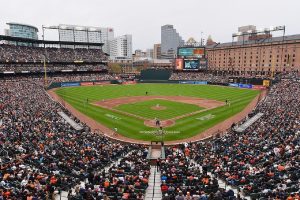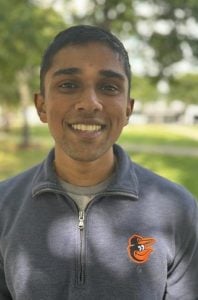
For Ashwin Pasupathy ’23, pursuing a doctorate in chemical engineering was always the plan. At Johns Hopkins, he double majored in chemical and biomolecular engineering and applied mathematics and statistics while engaging in education-oriented extracurriculars like serving as a teaching assistant and tutoring local children.
Though his aspirations for teaching were clear, Pasupathy still wanted to participate in activities that reflected other personal interests. Enter Anton Dahbura and his sports analytics research group. While Dahbura’s primary appointments include serving as the executive director of the Johns Hopkins University Information Security Institute and as co-director of the Johns Hopkins Institute for Assured Autonomy, it was his research focused on sports analytics and scheduling optimization as an associate research scientist within the Whiting School of Engineering’s computer science department that captivated Pasupathy, a former high school baseball player.
Beginning in December 2022, Pasupathy contributed a few hours each week to Dahbura’s Orioles-oriented research focused on optimizing the team’s lineup. A discussion following an end-of-semester presentation coupled with Dahbura’s connections with the Orioles—including with Sig Mejdal, vice president and assistant general manager of analytics, Di Zou, director of baseball systems, and data scientist James Hull—eventually led to Pasupathy’s first full-time role out of college. Between graduating in May and starting his PhD program in chemical engineering in late August, Pasupathy served as an analyst fellow with the team this past summer.

Ashwin Pasupathy
In his role, Pasupathy sat in on major events, including the 2023 Major League Baseball Draft, where he saw the Orioles make speedy Vanderbilt centerfielder Enrique Bradfield Jr. the team’s top draft pick. But day to day, Pasupathy built on the project he started as an undergraduate research assistant with Dahbura. He sorted “functional data”—derived from the Orioles’ innovative camera system that precisely calculates the location of the hitter’s joints and bat at any point in time during the interval of a pitch—and proposed questions to Hull, who then helped him define action steps toward developing answers.
In a broad sense, Pasupathy wanted to know if he compiled enough functional data on each player’s unique movements, could he derive models that maximized player hitting success rates? Could he develop models that can distinguish “good” swings from “bad?” While his summer internship “probably concluded with more questions than answers,” Pasupathy was excited to take ownership of the project and collaborate to explore possible approaches.
With the Orioles’ baseball operations staff, Pasupathy found an enthusiastic data- and curiosity-driven culture under Elias’ leadership. The Orioles’ cultural openness mirrored his experiences as a Hopkins undergraduate, where he had the freedom to pursue his interests. And his Hopkins experience positively shaped Pasupathy’s work approach with the Orioles by encouraging him to learn from peers with divergent backgrounds and perspectives, including on topics he may not necessarily incorporate into his own career moving forward.
Though Pasupathy’s stint with the Orioles was short, he left Baltimore with many memories and lessons learned. Moving from one curiosity-driven environment to another, he’s entering his PhD program with newfound confidence and “positive momentum.”
Regardless of this year’s playoff outcomes, Pasupathy saw the Orioles flourish on the field and played a role on the dynamic baseball operations staff that dutifully worked behind them.